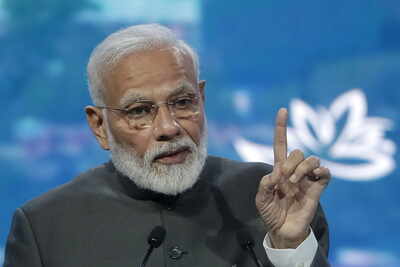
September 6 marks an important date for India as well as Narendra Modi government’s second term (Modi 2.0). After being sworn in on May 30, the government completes 100 days on Friday.
Moreover, it was exactly a month ago on August 6 that Parliament nullified Articles 370 and 35A of the Constitution. While stripping Jammu and Kashmir of its special status, the government also bifurcated the state by carving out Ladakh as a separate Union territory. The government had put several restrictions with many of them yet to be lifted as the Union territory remains to return to normalcy.
The Narendra Modi government observed two milestones and enumerated its achievements on completion of 50 days and 75 days. However, what differentiates from the earlier two milestones is the state of the economy. If the government had only achievements to boast on completion of 50 and 75 days, the slow economic growth has dampened the 100 days’ milestone.
The government is beset with challenges on the economy front. That the country’s economy is not on a stable footing came to the fore in the last week of August.
As per the GDP data released by National Statistical Office (NSO) on August 30, India's economy grew by 5 per cent in the April-June quarter. It had grown at 5.8 per cent in the previous quarter.
This 5 per cent GDP in the first quarter of the current financial year is the slowest in more than six years. The previous low of 4.3 per cent was registered in January-March 2013 during Manmohan Singh-led UPA rule.
This alarming situation prompted finance minister Nirmala Sitharaman to announce a slew of economic reforms to salvage the situation. This included mergers of 10 public sector banks into four and the Reserve Bank of India (RBI) deciding to transfer Rs 1.76 lakh crore in dividend and surplus reserve to the government.
The government promised cheaper home and auto loans, higher depreciation for all vehicles, GST refunds to micro, small and medium enterprises (MSMEs) within 30 days, release of Rs 70,000 crore to boost liquidity of banks and the likes.
The government has taken steps to codify labour laws and help small and medium-sized enterprises. Changes in the labour code is likely to benefit 400 million informal sector workers through wage and labour security.
While these economic measures may show their impact in due course of time, the Modi government took several notable and even historic steps in the last 100 days.
After the Muslim Women (Protection of Rights on Marriage) Bill, popularly called the instant triple talaq bill, failed twice to get passed in the Rajya Sabha in the 16th Lok Sabha, the government prepared a foolproof floor management and ensured its passage by Parliament in July. The BJP fulfilled a major promise made in its manifesto for 2019 Lok Sabha election.
This was closely followed by the nullification of Articles 370 and 35A of the Constitution pertaining to Jammu and Kashmir. On August 5, the Rajya Sabha passed the Jammu and Kashmir Reorganisation Bill changing the status of the state to a Union territory with legislative assembly.
The state was also bifurcated with Ladakh getting carved out as a separate Union territory without a legislative assembly. The Lok Sabha passed the bill on August 6.
Abrogation of Articles 370 and 35A was another long-pending issue of the BJP and it was one of the oldest items in the party’s election manifesto.
However, the BJP fulfilled the promise by putting a number of restrictions on Jammu and Kashmir, which is undergoing a spell of President’s Rule. It placed prominent leaders such as former chief ministers Omar Abdullah and Mehbooba Mufti of the National Conference (NC) and the People’s Democratic Party (PDP) respectively under house arrest. It also imposed curfew and section 144 in most parts of the erstwhile state.
Pakistan sought to internationalise the issue. The neighbouring country’s prime minister Imran Khan met US President Donald Trump after which the latter offered to mediate in the Kashmir issue.
Pakistan moved the UN Security Council (UNSC) over Kashmir and with the help of China sought to get India censured. On the contrary, in the closed door meeting of the UNSC, Pakistan and China got isolated as all other countries refused to back them. It was a major diplomatic victory of India over Kashmir.
Prime Minister Narendra Modi met Donald Trump in Biarritz in France at the G-7 conclave. Trump and Modi said they discussed Kashmir and declared that it was a bilateral issue between India and Pakistan. Trump did not talk about mediating between the two countries.
However, back home, the situation in the state is still not normal. The government has lifted restrictions on landline phones. It is set to normalise mobile phone connectivity in the days to come.
The government said the restrictions ensured that there was no death of a single citizen.
Apart from this, the government boasted of other achievements. The monsoon session of Parliament recorded a historic productivity. The first session of the 17th Lok Sabha with Speaker Om Birla in the chair was the most productive session since 1952. In a cascading effect, the Rajya Sabha also improved its performance for the first time after several decades.
Earlier, the Modi government 2.0 fulfilled its election promises regarding farmers. It declared that all the 14 crore farmers would be covered under the PM Kisan Samman Nidhi Yojana which offers Rs 6,000 per annum to every farmer. All farmers are also now eligible for pension scheme. The government would spend over Rs 10,000 crore over three years on social security cover for farmers.
As promised before elections, the Modi government established a separate Jal Shakti ministry - for assured potable water supply to every home.
The government has also taken a number of steps in the health and medical education sector. Parliament passed the National Medical Commission Bill which provides for one common entrance ‘NEET’ exam and one exit exam. It also ensures fee regulation in the private colleges.
On August 28, the Cabinet committee on economic affairs approved setting up of 75 government medical colleges at a cost of Rs 24,375 crore. These colleges would be attached with existing district or referral hospitals by 2021-22. It is expected to add at least 15,700 MBBS seats, increase availability of doctors and improve tertiary care in government hospitals among others.
The Modi government has reiterated its resolve to turn India into a $5-trillion economy. In the first 50 days, it took a number of steps to enhance the flow of foreign and domestic investments. It revamped Insolvency and Bankruptcy Code (IBC), recapitalised public sector banks with Rs 70,000 crore and undertaken disinvestment.
It has decided to inject investment of whopping Rs 100 lakh crore in next five years in infrastructure – road, rail, port, airport, industrial corridors, freight corridors, Jal Marg Vikas, Udaan and Pradhan Mantri Gramin Sadak Yojana (PMGSY) Phase III.
While addressing the nation from the ramparts of Red Fort on August 15, Narendra Modi announced a campaign to ban single-use plastic. He repeated his appeal on his last monthly radio programme ‘Mann Ki Baat’ aired on August 25.
As a crusade against corruption, several senior officers have been summarily removed from the services.
Chandrayaan-2 was launched on July 22 to help trace back the origin and evolution of the Moon and to address the origin of water. It is all set to land on the Moon on September 7.
The government safeguarded children against sexual crimes through amendments to the Prevention of Children from Sexual Offences Act (POCSO Act).
PM Modi’s first decision after assuming office for the second term was to approve scholarships for children of slain military and police personnel.
One of his last decisions in 100 days has been the launch of ‘Fit India Movement’ on August 29 - National Sports Day. It is a campaign to make India a young and fit nation full of positivity.
Moreover, it was exactly a month ago on August 6 that Parliament nullified Articles 370 and 35A of the Constitution. While stripping Jammu and Kashmir of its special status, the government also bifurcated the state by carving out Ladakh as a separate Union territory. The government had put several restrictions with many of them yet to be lifted as the Union territory remains to return to normalcy.
The Narendra Modi government observed two milestones and enumerated its achievements on completion of 50 days and 75 days. However, what differentiates from the earlier two milestones is the state of the economy. If the government had only achievements to boast on completion of 50 and 75 days, the slow economic growth has dampened the 100 days’ milestone.
The government is beset with challenges on the economy front. That the country’s economy is not on a stable footing came to the fore in the last week of August.
As per the GDP data released by National Statistical Office (NSO) on August 30, India's economy grew by 5 per cent in the April-June quarter. It had grown at 5.8 per cent in the previous quarter.
This 5 per cent GDP in the first quarter of the current financial year is the slowest in more than six years. The previous low of 4.3 per cent was registered in January-March 2013 during Manmohan Singh-led UPA rule.
This alarming situation prompted finance minister Nirmala Sitharaman to announce a slew of economic reforms to salvage the situation. This included mergers of 10 public sector banks into four and the Reserve Bank of India (RBI) deciding to transfer Rs 1.76 lakh crore in dividend and surplus reserve to the government.
The government promised cheaper home and auto loans, higher depreciation for all vehicles, GST refunds to micro, small and medium enterprises (MSMEs) within 30 days, release of Rs 70,000 crore to boost liquidity of banks and the likes.
The government has taken steps to codify labour laws and help small and medium-sized enterprises. Changes in the labour code is likely to benefit 400 million informal sector workers through wage and labour security.
While these economic measures may show their impact in due course of time, the Modi government took several notable and even historic steps in the last 100 days.
After the Muslim Women (Protection of Rights on Marriage) Bill, popularly called the instant triple talaq bill, failed twice to get passed in the Rajya Sabha in the 16th Lok Sabha, the government prepared a foolproof floor management and ensured its passage by Parliament in July. The BJP fulfilled a major promise made in its manifesto for 2019 Lok Sabha election.
This was closely followed by the nullification of Articles 370 and 35A of the Constitution pertaining to Jammu and Kashmir. On August 5, the Rajya Sabha passed the Jammu and Kashmir Reorganisation Bill changing the status of the state to a Union territory with legislative assembly.
The state was also bifurcated with Ladakh getting carved out as a separate Union territory without a legislative assembly. The Lok Sabha passed the bill on August 6.
Abrogation of Articles 370 and 35A was another long-pending issue of the BJP and it was one of the oldest items in the party’s election manifesto.
However, the BJP fulfilled the promise by putting a number of restrictions on Jammu and Kashmir, which is undergoing a spell of President’s Rule. It placed prominent leaders such as former chief ministers Omar Abdullah and Mehbooba Mufti of the National Conference (NC) and the People’s Democratic Party (PDP) respectively under house arrest. It also imposed curfew and section 144 in most parts of the erstwhile state.
Pakistan sought to internationalise the issue. The neighbouring country’s prime minister Imran Khan met US President Donald Trump after which the latter offered to mediate in the Kashmir issue.
Pakistan moved the UN Security Council (UNSC) over Kashmir and with the help of China sought to get India censured. On the contrary, in the closed door meeting of the UNSC, Pakistan and China got isolated as all other countries refused to back them. It was a major diplomatic victory of India over Kashmir.
Prime Minister Narendra Modi met Donald Trump in Biarritz in France at the G-7 conclave. Trump and Modi said they discussed Kashmir and declared that it was a bilateral issue between India and Pakistan. Trump did not talk about mediating between the two countries.
However, back home, the situation in the state is still not normal. The government has lifted restrictions on landline phones. It is set to normalise mobile phone connectivity in the days to come.
The government said the restrictions ensured that there was no death of a single citizen.
Apart from this, the government boasted of other achievements. The monsoon session of Parliament recorded a historic productivity. The first session of the 17th Lok Sabha with Speaker Om Birla in the chair was the most productive session since 1952. In a cascading effect, the Rajya Sabha also improved its performance for the first time after several decades.
Earlier, the Modi government 2.0 fulfilled its election promises regarding farmers. It declared that all the 14 crore farmers would be covered under the PM Kisan Samman Nidhi Yojana which offers Rs 6,000 per annum to every farmer. All farmers are also now eligible for pension scheme. The government would spend over Rs 10,000 crore over three years on social security cover for farmers.
As promised before elections, the Modi government established a separate Jal Shakti ministry - for assured potable water supply to every home.
The government has also taken a number of steps in the health and medical education sector. Parliament passed the National Medical Commission Bill which provides for one common entrance ‘NEET’ exam and one exit exam. It also ensures fee regulation in the private colleges.
On August 28, the Cabinet committee on economic affairs approved setting up of 75 government medical colleges at a cost of Rs 24,375 crore. These colleges would be attached with existing district or referral hospitals by 2021-22. It is expected to add at least 15,700 MBBS seats, increase availability of doctors and improve tertiary care in government hospitals among others.
The Modi government has reiterated its resolve to turn India into a $5-trillion economy. In the first 50 days, it took a number of steps to enhance the flow of foreign and domestic investments. It revamped Insolvency and Bankruptcy Code (IBC), recapitalised public sector banks with Rs 70,000 crore and undertaken disinvestment.
It has decided to inject investment of whopping Rs 100 lakh crore in next five years in infrastructure – road, rail, port, airport, industrial corridors, freight corridors, Jal Marg Vikas, Udaan and Pradhan Mantri Gramin Sadak Yojana (PMGSY) Phase III.
While addressing the nation from the ramparts of Red Fort on August 15, Narendra Modi announced a campaign to ban single-use plastic. He repeated his appeal on his last monthly radio programme ‘Mann Ki Baat’ aired on August 25.
As a crusade against corruption, several senior officers have been summarily removed from the services.
Chandrayaan-2 was launched on July 22 to help trace back the origin and evolution of the Moon and to address the origin of water. It is all set to land on the Moon on September 7.
The government safeguarded children against sexual crimes through amendments to the Prevention of Children from Sexual Offences Act (POCSO Act).
PM Modi’s first decision after assuming office for the second term was to approve scholarships for children of slain military and police personnel.
One of his last decisions in 100 days has been the launch of ‘Fit India Movement’ on August 29 - National Sports Day. It is a campaign to make India a young and fit nation full of positivity.
more from times of india news
Trending Topics
More from TOI
Navbharat Times
Featured Today in Travel
Quick Links
Article 370RTI BillPodcast newsYamuna FloodG7 SummitMaharashtra election 2019West Bengal ElectionTamil Nadu election 2019UP Election 2019Bihar election 2019UP Election DateAndhra Election DateBihar Election DateAndhra Assembly ElectionLok SabhaMP Election DateMaharashtra Election DateShiv SenaYSRCPTDPWB Election DateJDUCongressBJP newsGujarat Election DateSC ST ActUIDAIIndian ArmyISRO newsSupreme CourtRajasthan Election DateTelangana Election DateTamilrockers 2018Uttarakhand newsSikkim newsOrrisa newsKarnataka Election DateNagaland newsSatta KingManipur newsMeghalaya news
Get the app









